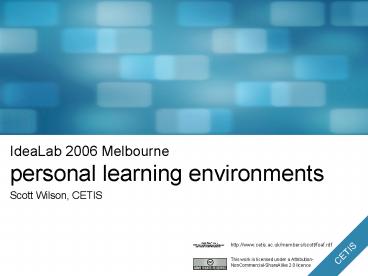IdeaLab 2006 Melbourne personal learning environments - PowerPoint PPT Presentation
1 / 40
Title:
IdeaLab 2006 Melbourne personal learning environments
Description:
Ivan Illich, Deschooling Society (1970) and Tools for Conviviality (1973) ... Derrick de Kerckhove, Connected Intelligence (1997) CETIS. Future VLE: Scott Wilson ... – PowerPoint PPT presentation
Number of Views:39
Avg rating:3.0/5.0
Title: IdeaLab 2006 Melbourne personal learning environments
1
IdeaLab 2006 Melbournepersonal learning
environments
- Scott Wilson, CETIS
http//www.cetis.ac.uk/members/scott/foaf.rdf
This work is licensed under a Attribution-NonComme
rcial-ShareAlike 2.0 licence
2
CETIS - a bit of history
- Strategic service to JISC
- IMS specifications and MLEs
- Web Services and SOA
- PLE and Web 2.0
3
The JISC PLE project
- Articulate and understand the educational context
(LLL, LWL, IL) from a range of perspectives - Identify the technologies needed
- Model the space
- Develop prototypes to help explore
- Stimulate a public discussion
4
Shock of the old
- Ivan Illich, Deschooling Society (1970) and Tools
for Conviviality (1973) - Christopher Alexander, A Pattern Language (1977
see esp. 18, 43, 83, 85) - Derrick de Kerckhove, Connected Intelligence
(1997)
5
Future VLE Scott Wilson
6
How did we get here?
7
(No Transcript)
8
(No Transcript)
9
Web 2.0?
10
The message of all this media
- the world beyond the university is now a richer
technology environment than at any time before in
the history of ICT, and is now arguably much
richer than that inside. - This potentially changes everything to do with
educational technology.
11
(No Transcript)
12
Technology-enhanced learners
- New assumptions and interventions
- The net generation
- Moving from provisioning and user support to
coordination and consultancy services - Moving from (just) courses and cohorts to
learning networks?
13
Learning Networks
- Combining formal and informal learning episodes
- Using shared goals, interests, or practices to
forge a social identity - Symmetry of experience of technologies in
informal and formal discovery and action
14
Learning Networks (2)
- In the future, will learners already be part of a
learning network before joining a course? - Will they have a pre-existing community of peers?
- Can institutions be facilitators of learning
networks instead of purveyors of courses? - Can we build upon our current capability to
introduce students into professional networks? - Is an orientation to competences a way forward?
(Or just yet another load of ontology?)
15
From provisioning to connecting
- Currently we provision learners and teachers with
technology - we give them a space, email
accounts etc. - The PLE approach would be instead to enable
connecting people with each other and resources
of mutual relevance
16
(No Transcript)
17
Content as infrastructure
- David Wiley, ICALT 2006 Kerkrade
- We must strive to make content free, open,
modifiable, re-distributable, and use
widely-understood formats that can be edited
easily - Content must become infrastructure (ubiquitous
and invisible)
18
PLEs for TEL
- Device (e.g. phone, PDA, laptop)
- Browser (e.g. Flock, Firefox)
- Aggregator and publisher (e.g. Plex, iTunes)
- Web desktop (e.g. Netvibes, Pageflakes)
- Blog-centred mashup
- Ad-hoc (e.g. interplay of various sites)
19
But!
- A PLE is personally constructed and discovered -
you dont provide a PLE like you provide the
VLE. Its not a box - Working with PLEs is about tailoring the
infrastructure to support and extend the
capabilities of TELs - Coordination in PLEs can be emergent
20
(No Transcript)
21
netvibes
22
Blog add-ons
23
Adaptation strategies for web 2.0
- Ignore
- Co-opt embrace extend
- Invert contribute support
24
1. Ignore
25
added by me using GreaseMonkey
26
2. Co-opt
- Requires subtlety, and understanding of different
social factors and affordances of informal and
formal learning
27
(No Transcript)
28
(No Transcript)
29
(No Transcript)
30
3. Invert
- PLE is an inversion strategy, and is potentially
disruptive
31
VLE -gt PLE
32
(No Transcript)
33
Transformation demands
- From hosting to consultancy (HE no longer an ISP
or corporate IT provider) - From closed to open ethos on content, systems,
processes - Adding value to the Internet, not duplicating
functionality with added control mechanisms - Not duplicating basic home ICT but instead
providing specialized collaboration facilities - FILLING THE FEATURE GAP
34
Contributing
- Our information - data, research, publications,
content via open web APIs - Our expertise
- Our offerings and products
- Our role as facilitators, guides, and trusted
source
35
VLE-gtPLE feature gap
- Assessment, marking and grading
- Drop boxes, and other patented things -)
- Gateway model (PebblePad)
- Coordination
- Workflow and learning activity designs
- NOT gaps
- PLE approach has better tracking/monitoring and
group formation (if you shift perspectives a
little)
36
Coordination and workflow
- How to enable coordination in heterogeneous
environments? - Can we coordinate (in the cybernetic sense)
instead of command? - Is resource management and provisioning (i.e.
command of the environment) strictly necessary?
37
Weblog and Aggregation Organisational Online
Communication Model - James Farmer
38
Activity design and monitoring Interaction point
PLE interaction point
(This model could apply to some extent to SCORM
and SS, but)
39
Dynamic goal-directed states within a rich policy
framework
40
Your ideas?
41
Cheers!
- scott.bradley.wilson_at_gmail.com
- http//www.cetis.ac.uk/members/scott
- http//www.cetis.ac.uk/members/ple
- http//del.icio.us/tag/ple































